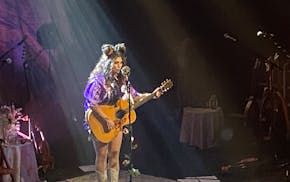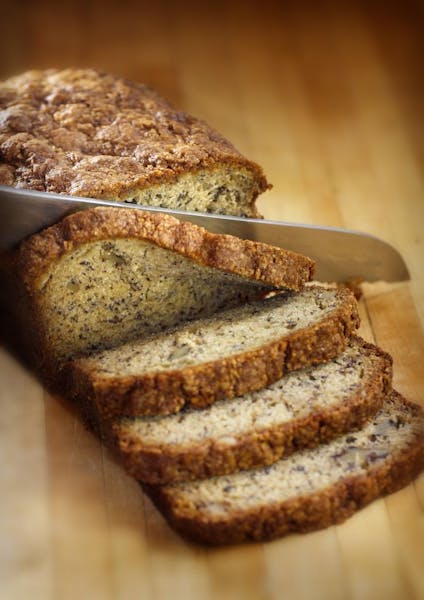At the Minnesota State Fair, the banana bread competition always attracts a crowd. Curt Pederson, the superintendent for Creative Activities, said it's as if entrants planning their strategies for cloverleaf rolls and sponge cakes say, "OK, I'm baking already. I may as well also bake and enter banana bread."
The display case, however, often reveals why banana bread shouldn't be an afterthought. There are pale loaves and scorched loaves. Some interiors look gooey, while others resemble sawdust. For all the angst reserved for yeast breads, a successful quick bread also demands its own set of skills.
Fortunately, a foolproof banana bread is within reach of anyone with a mixer and some ugly bananas.
In fact, mottled, mushy, overripe bananas probably are the reason that this bread became a staple of morning coffee breaks and after-school snacks.
It's actually the result of Yankee ingenuity made possible by two ingredients imported from foreign shores: baking soda, first brought from England in 1846, and bananas, which first appeared here in 1870, the new fruit memorably described by Philadelphia confectioner Eleanor Parkinson as having "a highly grateful flavour."
Yet it appears that decades passed before thrifty housewives were faced with overripe fruit, their exotic novelty perhaps finally wearing off. In any case, the popularization of baking soda and baking powder in the 1930s led to the first published recipe appearing in 1933 in Pillsbury's "Balanced Recipes" cookbook, thereby lending a laudable Minnesota connection to this iconic baked good.
Oddly enough, you can't make banana bread on a whim. Gorgeous canary-yellow bananas aren't soft enough to blend evenly, nor flavorful enough to make the effort worthwhile. You may need to plan ahead, buying some bananas to "age" on your counter or, conversely, exercise a bit of spontaneity when encountering a display of overripe fruit.
If you're nice to the produce people -- and who wouldn't be? -- they might be able to retrieve some older bananas from the back room. Or you can keep your own treasure trove in the freezer, placing overripe bananas still in their skins on the shelf. Once thawed and peeled, they're perfectly mushy and recipe-ready.
Once you have the right bananas, the rest of the assembly is easy, with three key concepts:
• Cream together the shortening or butter with the sugar until the mixture is light and fluffy. The air beaten into the batter will make a loftier, more tender loaf.
• Whisk together the dry ingredients in a small bowl to make sure that the rising agents -- the baking soda and baking powder -- are thoroughly mixed. A pocket of either in a finished loaf can taste bitter.
• Start baking with a burst of high heat. One of the challenges with moist quick breads is determining when they are baked through. Danny Klecko, master baker with Saint Agnes Baking Co. in St. Paul, recommends giving quick breads an initial burst of heat, which makes the batter "pop" and helps develop a crumb wall that supports the moist batter as it bakes. After 8 to 10 minutes at 400 degrees, the loaf then finishes baking at the traditional 350 degrees.
Klecko's final tip: "A loaf that's close to being done will pull away from the sides of the pan."
A slice of classic banana bread is comfort food at its best. But over time, bakers have realized that it's a welcoming backdrop for additions such as chocolate chips, blueberries, coconut, diced dates, pineapple -- whatever strikes your fancy. The accompanying recipe can accommodate one cup of add-ins. To keep them from "sinking" in the batter, toss them with a tablespoon of flour before stirring them in.
Kim Ode • 612-673-7185
Oregon's Sports Bra, a pub for women's sports fans, plans national expansion as interest booms
Biden will give election-year roast at annual correspondents' dinner as protests await over Gaza war
Retrial of Harvey Weinstein unlikely to occur soon, if ever, experts say

Harvey Weinstein hospitalized after his return to New York from upstate prison

